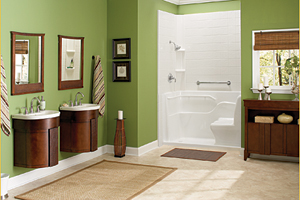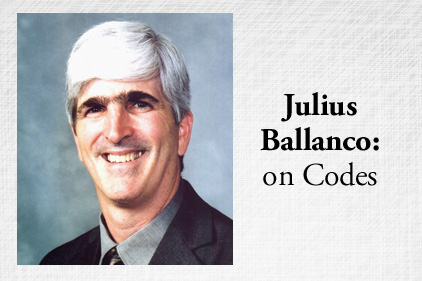
|
|
A change to the minimum flow rate sizing table lowered the flow rate to showers, lavatories and sinks. This table is used by a designer to size the water piping system. Photo courtesy of American Standard |
The committee hearing the plumbing and mechanical changes is unique. Four representatives from the National Association of Home Builders serve on the committee. That’s four of 10 total voting members, including the chair, coming from one association. The four NAHB representatives tend to vote as a block on most issues.
Many of the changes being considered were “wordsmithing” of code sections or code requirements. Other changes included the addition of new material or fixtures such as CPVC/AL/CPVC pipe, polypropylene tube and dual-flush water closets.
Flow chatter
A heated debate ensued regarding flush volumes and flow rates. There was a change to require the water closet flush volume to be lowered to 1.3 gpf — the rounding up of a 1.28-gpf water closet. The requirement would apply only to water closets in one- and two-family dwellings and townhouses.
Part of the change included a lowering of the flow rates for showers and lavatories. Showers would be lowered to 2.0 gpm, down from 2.5 gpm. Lavatories would be lowered to from 2.2 gpm to 1.5 gpm. The proposal was presented as a water- and energy-conservation measure.
The lowering of flow rates and flush volume received support from energy and green representatives, as well as a few engineers. The opposition was led by NAHB and Plumbing Manufacturers International. Both claimed owners should have a choice as to what water closet or showerhead they use. The argument against this is owners rarely are involved in the decision since they are buying a house based on what the contractor installed. The Residential Plumbing Committee recommended the rejection of the proposal to lower the flow rates and flush volume.
Another energy measure included numerous proposed changes to require hot water recirculation. The proposal ranged from requiring recirculation based on volume of water to a maximum distance of 50 ft. from the water heater. The 50-ft. requirement would have brought the IRC plumbing section in line with the International Plumbing Code. NAHB portrayed the requirement as an expensive nicety that should not be mandated in a minimum code. The counter argument emphasized the water savings by having hot water delivered within 10 seconds.
The committee recommended denial of all recirculation piping changes, indicating such requirements were beyond a minimum code.
A change to the minimum flow rate sizing table lowered the flow rate to showers, lavatories and sinks. This table is used by a designer to size the water piping system. The flow rate to lavatories was proposed to be dropped from 2 gpm to 0.8 gpm. The flow rate to showers would lower from 3 gpm to 2.5 gpm and to sinks it would lower from 2.5 gpm to 1.75 gpm. The change was recommended for approval.
Sprinklers, green and more …
There was a change proposed to the residential sprinkler system to remove the option for standalone systems in P2904. This section currently allows either a standalone or multipurpose sprinkler system. The justification had more to do with licensing and who installs what system than on any life-safety matter. Those opposed testified the section was intended to include both multipurpose and standalone systems. The committee recommended denial of the change.
The IRC plumbing section has a restriction on connecting a food-waste disposer to a combination waste-and-vent system. This has presented a hardship in certain island and peninsula installations. The ASPE Research Foundation studied the impact of a food-waste disposer. The test report indicates there is no problem with such an installation.
The committee approved the change to allow food-waste disposers to discharge to a combination waste-and-vent system based on the ASPE Research Foundation report.
A complete rewrite of the reclaimed water section was considered. The proposed change would update the requirements to be consistent with the Green Code provisions. The change was approved, making the requirements consistent between the Green Code, the International Plumbing Code and the IRC.
One of the shocking changes occurred toward the end of the plumbing hearing. There was a proposal to accept inline sanitary waste valves in place of traps. The best way to describe these devices is a tube with a flexible bladder inside. When waste hits the flexible bladder, it opens up. When there is no waste, the bladder closes the opening, sealing off sewer gas.
These devices always have elicited a lot of discussion and opposition. The general concern is whether a mechanical device can replace a 2-in. water trap seal. The committee voted to approve the change. During the committee discussion, it indicated the product had a consensus standard and the code shouldn’t inhibit innovation.
Following the plumbing hearings, the same committee listened to all code changes to the IRC mechanical section. Mechanical was dominated by discussions on ventilation and exhaust. The new Energy Code requirements have resulted in dwelling units being so tight that outside air is required for ventilation. This has impacted the performance of exhaust systems and fuel-fired appliances.
This is the first step in the code-change process. The results of the committee recommendations are published on the ICC website at www.iccsafe.org. Anyone is permitted to file a public comment on the committee recommendations. The public comments will be published in August. These comments will become the agenda for the final hearing to be held the first week of October in Atlantic City.



